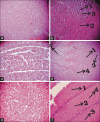Toxicity study of Lauha Bhasma (calcined iron) in albino rats
- PMID: 27143800
- PMCID: PMC4850776
- DOI: 10.4103/0257-7941.179870
Toxicity study of Lauha Bhasma (calcined iron) in albino rats
Abstract
Background: Lauha Bhasma (LB) is a complex herbomineral preparation widely used as an Ayurvedic hematinic agent. It is an effective remedy for chronic fever (jīrṇa jvara), phthisis (kṣaya), Breathlessness (śvāsa) etc., and possesses vitality enhancing (vājīkara), strength promoting and anti aging (rasāyana) properties.
Objectives: The present work was conducted to establish the safety aspects of the use of Lauha bhasma.
Setting and design: LB was prepared by Ayurvedic procedures of purification (śodhana), sun drying (bhānupāka), sthālīpāka, followed by repeated calcination (māraṇa) and "nectarization" (amṛtīkaraṇa). The resultant product was subjected to acute and sub acute toxicity studies.
Materials and methods: Acute and subacute toxicity study of LB was conducted in albino rats. Criteria for assessment included ponderal changes, change in biochemical parameters viz., LFT and KFT and hematological parameters. Histopathological studies of different organs including liver, kidney, spleen, testis etc., were also conducted to observe pathological changes if any.
Results: In the acute toxicity study, the animal group did not manifest any signs of toxicity and no mortality was observed up to 100 times the therapeutic dose (TD). Significant increase in blood urea (27.83%, P < 0.01), serum creatinine (30.92%, P < 0.05), Aspartate aminotransferase (15.09%, P < 0.05), and serum alkaline phosphatase (27.5%, P < 0.01) was evident in group IV (10 TD). A significant increase in serum total protein (6.04%, P < 0.05) level was observed in group III (5 TD). Histopathological examination of livers in group IV (10 TD) showed mild inflammation in terms of bile stasis, peri-portal hepatic inflammation and sinusoidal congestion; lymphocyte infiltration in kidney and intracellular deposits in the splenic tissue.
Conclusion: Lauha Bhasma was found to be safe at the therapeutic dose and also at five times the therapeutic dose levels. However, alteration in some of the biochemical and haematological parameters along with histopathological findings were evident at the highest dose level.
Keywords: Biochemical; Lauha bhasma; histopathology; liver; spleen Triphala; toxicity.
Figures


Similar articles
-
Standard manufacturing procedure of Teekshna lauha bhasma.J Ayurveda Integr Med. 2016 Apr-Jun;7(2):100-8. doi: 10.1016/j.jaim.2015.08.003. Epub 2016 Jul 20. J Ayurveda Integr Med. 2016. PMID: 27450759 Free PMC article.
-
Pharmaceutical study of Lauha Bhasma.Ayu. 2010 Jul;31(3):387-90. doi: 10.4103/0974-8520.77157. Ayu. 2010. PMID: 22131745 Free PMC article.
-
Acute and Subchronic Toxicity Study of Tamra Bhasma (Incinerated Copper) prepared from Ashodhita (Unpurified) and Shodhita (Purified) Tamra in Rats.Indian J Pharm Sci. 2013 May;75(3):346-52. doi: 10.4103/0250-474X.117433. Indian J Pharm Sci. 2013. PMID: 24082351 Free PMC article.
-
Anti-diabetic formulations of Nāga bhasma (lead calx): A brief review.Anc Sci Life. 2013 Jul;33(1):52-9. doi: 10.4103/0257-7941.134609. Anc Sci Life. 2013. PMID: 25161332 Free PMC article. Review.
-
Bhasma : The ancient Indian nanomedicine.J Adv Pharm Technol Res. 2014 Jan;5(1):4-12. doi: 10.4103/2231-4040.126980. J Adv Pharm Technol Res. 2014. PMID: 24696811 Free PMC article. Review.
Cited by
-
Chemical Compositions of Metals in Bhasmas and Tibetan Zuotai Are a Major Determinant of Their Therapeutic Effects and Toxicity.Evid Based Complement Alternat Med. 2019 Jan 10;2019:1697804. doi: 10.1155/2019/1697804. eCollection 2019. Evid Based Complement Alternat Med. 2019. PMID: 30941186 Free PMC article. Review.
-
Prospective Application of Nanoparticles Green Synthesized Using Medicinal Plant Extracts as Novel Nanomedicines.Nanotechnol Sci Appl. 2021 Sep 23;14:179-195. doi: 10.2147/NSA.S333467. eCollection 2021. Nanotechnol Sci Appl. 2021. PMID: 34588770 Free PMC article.
-
Assessment of Chronic Toxicity of an Ayurvedic Herbo-Metallic Formulation Rasaraj Rasa in Wistar Rats.J Pharmacopuncture. 2022 Dec 31;25(4):354-363. doi: 10.3831/KPI.2022.25.4.354. J Pharmacopuncture. 2022. PMID: 36628344 Free PMC article.
-
Evaluation of fertility toxicity and embryo-fetal developmental toxicity profile of Ayush AG, a compound herbo-mineral Ayurvedic formulation.J Ayurveda Integr Med. 2025 Jul-Aug;16(4):101154. doi: 10.1016/j.jaim.2025.101154. Epub 2025 Jun 28. J Ayurveda Integr Med. 2025. PMID: 40582044 Free PMC article.
-
Physico-chemical characterization of kajjali, black sulphide of mercury, with respect to the role of sulfur in its formation and structure.J Ayurveda Integr Med. 2021 Oct-Dec;12(4):590-600. doi: 10.1016/j.jaim.2021.05.006. Epub 2021 Nov 10. J Ayurveda Integr Med. 2021. PMID: 34772584 Free PMC article.
References
-
- Bansal A, Sairam M, Prasad D, Sharma SK, Ilavazhagan G, Kumar D, et al. Cytoprotective and immunomodulatory properties of Geriforte, a herbomineral preparation, in lymphocytes. Phytomedicine. 2001;8:438–44. - PubMed
-
- Balaji K, Narendran R, Brindha P, Sridharan K, Maheswari KU, Swaminathan S, et al. Scientific validation of the different purification steps involved in the preparation of an Indian Ayurvedic medicine, Lauha bhasma. J Ethnopharmacol. 2012;142:98–104. - PubMed
-
- Singh VC. Nicholas Piramal India Ltd, Mumbai, Herbal (Ayurvedic) Drug Industry for Compliance to Quality parameters, Regional Training Course at India International Centre, New Delhi. [Last accessed on 2010 Jan 6]. Available from: http://www.ics.trieste.it/media/134533/df2498.pdf .
-
- Kumar A, Nair AG, Reddy AV, Garg AN. Bhasmas: Unique ayurvedic metallic-herbal preparations, chemical characterization. Biol Trace Elem Res. 2006;109:231–54. - PubMed
-
- Nabar M, Pimpalgaonkar P, Laddha K. Studies on sodhana prakriya of gunja (Abrus precatorius Linn.) seeds. Indian J Tradit Knowl. 2011;10:693–6.
LinkOut - more resources
Full Text Sources
Other Literature Sources

